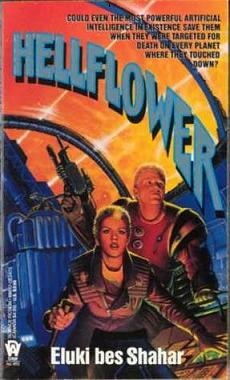
Hellflower
Eluki bes Shahar
252 pages
published in 1991
Eluki bes Shahar is a science fiction and fantasy writer better known as Rosemary Edghill, the form of her name she now prefers. She’s been active since the late eighties, starting her career writing straight romance novels, then moving on to science fiction and fantasy, most recently in collaboration with Mercedes Lackey. I think it’s fair to say she’s only been middling succesfull as a writer, somebody largely forgotten as an science fiction writer. The question is, is she worth rediscovering?
At first glance Hellflower seems to be a bog standard space opera or adventure sf story. Hardbitten female independent trader/starship captain rescues a young nob from a mugging, due to his honour he’s now in her debt, the same honour leads him to be scheduled for execution, she rescues him again, they take off from the planet guns blazing, he turns out to be more than just a young, bored noble and she’s in over her head. What makes Hellflower different from the several dozen other space opera stories with the same plot is the atmosphere of elegiac foredooming it takes place in. This particular caper might have a happy ending after all, but sooner or later the odds will catch up with our protagonist.
Said protagonist is Butterflies-are-free Peace Sincere st-Cyr, who grew up on a low technology reservation planet and broke the embargo into a precarious life in the Phoenix Empire. Her only friend and confidant is Paladin, the last existing AI left in the empire, now installed in Butterfly’s ship, The Firecat. AIs are feared and loathed in the empire, with Paladin being a remnant from an earlier golden age. Together they’ve so far managed to survive in an increasingly hostile universe, but Paladin knows if Butterfly doesn’t, or pretends to, that it’s just a matter of time before something goes wrong.
And Butterfly’s impromptu rescue of Tigger Stardust, young teenager hellflower aristocrat with an overinflated sense of honour, first from a gang of thugs, then from police imprisonment, looks very much like the straw that’ll break the camel’s back, as they’re hunted from one world to another. It soon becomes apparent that the trouble Tigger found himself in was not entirely of his own making, but that he has made powerful enemies because of who he is.
Though a fairly standard sf plot, what makes Hellflower different is the melancholic atmosphere. There’s none of the romance of the usual science fiction smuggler/freetrader adventurer; Butterfly St Cyr is no Han Solo. She’s scrabbling for a living on the margins of galactic society and her odds for survival are low and getting lower. There’s a sense of realism there that you don’t see a lot in science fiction, that of knowing you’re winning if you can manage to keep your head above water.
What I also liked was the relationship between Butterfly and Tigger, who against all odds don’t become lovers or romantically engaged, something even rarer in genre fiction. Tigger admires and looks up to Butterfly, while she is equal measures annoyed and amused by him, but neither is attracted by the other.
Finally, what also sets Hellflower apart is the language, which has echoes of Delany and Zelazny in its richness.
Which all in all means that yes, if you like good, fun adventure science fiction, this is a good bet.
No Comments